同济大学:《空气动力学》课程电子教案(课件讲稿)Chapter 1 Introduction to Aerodynamics(负责人:金哲岩)
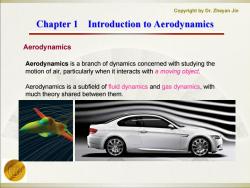
Copyright by Dr.Zheyan Jin Chapter 1 Introduction to Aerodynamics Aerodynamics Aerodynamics is a branch of dynamics concerned with studying the motion of air,particularly when it interacts with a moving object. Aerodynamics is a subfield of fluid dynamics and gas dynamics,with much theory shared between them
Copyright by Dr. Zheyan Jin Chapter 1 Introduction to Aerodynamics Chapter 1 Introduction to Aerodynamics Aerodynamics Aerodynamics is a branch of dynamics concerned with studying the motion of air, particularly when it interacts with a moving object. Aerodynamics is a subfield of fluid dynamics and gas dynamics, with much theory shared between them
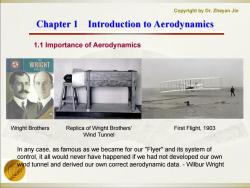
Copyright by Dr.Zheyan Jin Chapter 1 Introduction to Aerodynamics 1.1 Importance of Aerodynamics WRIGHT Wright Brothers Replica of Wright Brothers' First Flight,1903 Wind Tunnel In any case,as famous as we became for our"Flyer"and its system of control,it all would never have happened if we had not developed our own wind tunnel and derived our own correct aerodynamic data.-Wilbur Wright
Copyright by Dr. Zheyan Jin Chapter 1 Introduction to Aerodynamics Chapter 1 Introduction to Aerodynamics 1.1 Importance of Aerodynamics Replica of Wright Brothers' Wind Tunnel In any case, as famous as we became for our "Flyer" and its system of control, it all would never have happened if we had not developed our own wind tunnel and derived our own correct aerodynamic data. - Wilbur Wright Wright Brothers First Flight, 1903
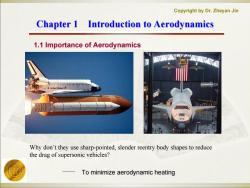
Copyright by Dr.Zheyan Jin Chapter 1 Introduction to Aerodynamics 1.1 Importance of Aerodynamics Why don't they use sharp-pointed,slender reentry body shapes to reduce the drag of supersonic vehicles? To minimize aerodynamic heating
Copyright by Dr. Zheyan Jin Chapter 1 Introduction to Aerodynamics Chapter 1 Introduction to Aerodynamics 1.1 Importance of Aerodynamics Why don’t they use sharp-pointed, slender reentry body shapes to reduce the drag of supersonic vehicles? To minimize aerodynamic heating
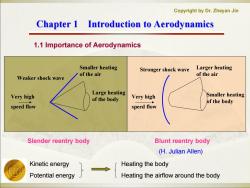
Copyright by Dr.Zheyan Jin Chapter 1 Introduction to Aerodynamics 1.1 Importance of Aerodynamics Smaller heating Stronger shock wave Larger heating of the air of the air Weaker shock wave Very high Large heating Very high Smaller heating of the body of the body speed flow speed flow Slender reentry body Blunt reentry body (H.Julian Allen) Kinetic energy Heating the body Potential energy Heating the airflow around the body
Copyright by Dr. Zheyan Jin Chapter 1 Introduction to Aerodynamics Chapter 1 Introduction to Aerodynamics 1.1 Importance of Aerodynamics Very high speed flow (H. Julian Allen) Smaller heating of the air L arge heating of the body Weaker shock w ave Very high speed flow Smaller heating of the body Stronger shock wave L arger h eating of the air Slender reentry body Blunt reentry body Heating the body Heating the airflow around the body Kinetic energy Potential energy

Copyright by Dr.Zheyan Jin Chapter 1 Introduction to Aerodynamics 1.2 Some Fundamental Aerodynamic Variables Fluid is used to denote either a liquid or a gas. Hydrodynamics-flow of liquids Fluid Dynamics Gas Dynamics-flow of gases Aerodynamics-flow of air The prediction of forces and moments on,and heat transfer to,bodies moving The objectives of through a fluid(usually air). Aerodynamics Determination of flows moving internally through ducts
Copyright by Dr. Zheyan Jin Chapter 1 Introduction to Aerodynamics Chapter 1 Introduction to Aerodynamics 1.2 Some Fundamental Aerodynamic Variables Fluid Dynamics Hydrodynamics – flow of liquids Gas Dynamics – flow of gases Aerodynamics – flow of air Fluid is used to denote either a liquid or a gas. The objectives of Aerodynamics The prediction of forces and moments on, and heat transfer to, bodies moving through a fluid (usually air). Determination of flows moving internally through ducts

Copyright by Dr.Zheyan Jin Chapter 1 Introduction to Aerodynamics 1.2 Some Fundamental Aerodynamic Variables Pressure: The normal force per unit area exerted on a surface due to the time rate of change of momentum of the gas molecules impacting on that surface. Density: Mass per unit volume. The temperature of a gas is directly proportional to the average kinetic energy of the molecules of the Temperature: fluid.In fact,if KE is the mean molecular kinetic energy,then temperature is given by KE=3kT/2, where k is the Boltzmann constant. velocity is the rate of change of position.It is Velocity: a vector physical quantity;both speed and direction are required to define it
Copyright by Dr. Zheyan Jin Chapter 1 Introduction to Aerodynamics Chapter 1 Introduction to Aerodynamics 1.2 Some Fundamental Aerodynamic Variables Pressure: The normal force per unit area exerted on a surface due to the time rate of change of momentum of the gas molecules impacting on that surface. Density: Mass per unit volume. The temperature of a gas is directly proportional to the average kinetic energy of the molecules of the fluid. In fact, if KE is the mean molecular kinetic energy, then temperature is given by KE=3kT/2, where k is the Boltzmann constant. Temperature: velocity is the rate of change of position. It is a vector physical quantity; both speed and direction are required to define it. Velocity: The temperature of a gas is directly proportional to the average kinetic energy of the molecules of the fluid. In fact, if KE is the mean molecular kinetic energy, then temperature is given by KE=3kT/2, where k is the Boltzmann constant. Temperature:
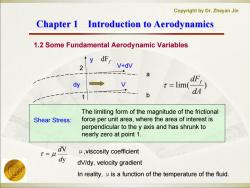
Copyright by Dr.Zheyan Jin Chapter 1 Introduction to Aerodynamics 1.2 Some Fundamental Aerodynamic Variables ↑yd V+dV 之-- dy t=lim( dA 1 The limiting form of the magnitude of the frictional Shear Stress: force per unit area,where the area of interest is perpendicular to the y axis and has shrunk to nearly zero at point 1. dv T=μ μ,viscosity coefficient y dV/dy,velocity gradient In reality,u is a function of the temperature of the fluid
Copyright by Dr. Zheyan Jin Chapter 1 Introduction to Aerodynamics Chapter 1 Introduction to Aerodynamics 1.2 Some Fundamental Aerodynamic Variables a b dy y V+dV V f dF y V d d 1 2 lim ( ) dA dFf The limiting form of the magnitude of the frictional force per unit area, where the area of interest is perpendicular to the y axis and has shrunk to nearly zero at point 1. Shear Stress: μ,viscosity coefficient dV/dy, velocity gradient In reality, μis a function of the temperature of the fluid
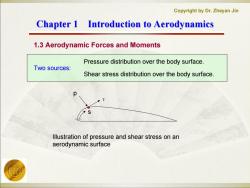
Copyright by Dr.Zheyan Jin Chapter 1 Introduction to Aerodynamics 1.3 Aerodynamic Forces and Moments Pressure distribution over the body surface. Two sources: Shear stress distribution over the body surface. Illustration of pressure and shear stress on an aerodynamic surface
Copyright by Dr. Zheyan Jin Chapter 1 Introduction to Aerodynamics Chapter 1 Introduction to Aerodynamics 1.3 Aerodynamic Forces and Moments Pressure distribution over the body surface. Two sources: Shear stress distribution over the body surface. τ p s Illustration of pressure and shear stress on an aerodynamic surface

Copyright by Dr.Zheyan Jin Chapter 1 Introduction to Aerodynamics 1.3 Aerodynamic Forces and Moments M R R Q L≡lit≡component of R perpendicular to D=drag component of R parallel to N=normal force component of R perpendicular to c A=axial force component of R parallel to c L=N cosa-Asina D=Nsina+Acosa
Copyright by Dr. Zheyan Jin Chapter 1 Introduction to Aerodynamics Chapter 1 Introduction to Aerodynamics 1.3 Aerodynamic Forces and Moments L ≡ lift ≡ component of R perpendicular to V V M R V D ≡ drag ≡ component of R parallel to α L c V N D R A α α N ≡ normal force ≡ component of R perpendicular to c A ≡ axial force ≡ component of R parallel to c sin cos L cos sin D N A N A

Copyright by Dr.Zheyan Jin Chapter 1 Introduction to Aerodynamics 1.3 Aerodynamic Forces and Moments S=planform area Area S I=c=chord length Dynamic pressure: The dimensionless force and moment coefficients: C=L 9.S CD=D 9.S 9.S C.=4 9.S 9.S7 Pressure coefficient: C。-p-p Skin friction coefficient: C1=-
Copyright by Dr. Zheyan Jin Chapter 1 Introduction to Aerodynamics Chapter 1 Introduction to Aerodynamics 1.3 Aerodynamic Forces and Moments l = c = ch o r d l ength 2 2 1 q V q p p C p V S= planform area Pressure coefficient: Skin friction coefficient: q Sl M q S A q S N q S D q S L L D N A M C C C C C c Area S Dynamic pressure: q f C The dimensionless force and moment coefficients:
按次数下载不扣除下载券;
注册用户24小时内重复下载只扣除一次;
顺序:VIP每日次数-->可用次数-->下载券;
- 长沙理工大学:《热力发电厂》课程教学资源(作业习题,无答案)第六章.docx
- 长沙理工大学:《热力发电厂》课程教学资源(作业习题,无答案)第五章.docx
- 长沙理工大学:《热力发电厂》课程教学资源(作业习题,无答案)第四章.docx
- 长沙理工大学:《热力发电厂》课程教学资源(作业习题,无答案)第三章.docx
- 长沙理工大学:《热力发电厂》课程教学资源(作业习题,无答案)第二章.docx
- 长沙理工大学:《热力发电厂》课程教学资源(作业习题,无答案)第一章.doc
- 长沙理工大学:《热力发电厂》课程教学资源(参考资料)湖南华润电力鲤鱼江有限公司300MW火电机组培训教材《锅炉设备及系统》电子版(共十四章).pdf
- 长沙理工大学:《热力发电厂》课程教学资源(参考资料)湖南华润电力鲤鱼江有限公司300MW火电机组培训教材《燃料运输设备及系统》电子版(共二十二章).pdf
- 长沙理工大学:《热力发电厂》课程教学资源(参考资料)湖南华润电力鲤鱼江有限公司300MW火电机组培训教材《汽轮机设备及系统》电子版.pdf
- 《热力发电厂》课程教学资源(教案讲义)热力发电厂授课教案教材(共八章).doc
- 华北电力大学:《热力发电厂》课程教学资源(讲稿)原则性热力系统与全面性热力系统.pdf
- 长沙理工大学:《热力发电厂》课程教学资源(参考资料)热力发电厂课程设计.pdf
- 《热力发电厂》课程教学资源(参考资料)热力发电厂常用计算符号表.doc
- 《热力发电厂》课程教学资源(参考资料)热力发电厂常用英语技术词汇.doc
- 《热力发电厂》课程教学资源(参考资料)汽机系统图例集.pdf
- 《热力发电厂》课程教学资源(参考资料)发电站热力系统图.pdf
- 长沙理工大学:《热力发电厂》课程教学资源(大纲教案)授课教案 Thermal Power Plant.pdf
- 长沙理工大学:《高等传热学》课程电子教案(PPT课件)第十章 槽道内层流流动与对流换热.pptx
- 长沙理工大学:《高等传热学》课程电子教案(PPT课件)第九章 紊流强迫对流传热.pptx
- 长沙理工大学:《高等传热学》课程电子教案(PPT课件)第四章 非稳态导热.pptx
- 同济大学:《空气动力学》课程电子教案(课件讲稿)Chapter 2 Some Fundamental Principles and Equations.pdf
- 同济大学:《空气动力学》课程电子教案(课件讲稿)Chapter 3 Fundamentals of Inviscid Inviscid, Incompressible Flow.pdf
- 同济大学:《空气动力学》课程教学资源(试卷习题)试卷 Final.doc
- 上海海洋大学:食品学院能源与动力工程和建筑环境与能源应用工程专业教学大纲汇编(2022年版).pdf
- 《电力系统继电保护原理》课程教学资源(文献资料)国家电网公司电力安全工作规程.pdf
- 《电力系统继电保护原理》课程教学资源(文献资料)电气规范汇编.doc
- 《电力系统继电保护原理》课程教学资源(试卷习题)电力系统继电保护题库(共三部分,含参考答案).doc
- 《电力系统继电保护原理》课程教学资源(试卷习题)电力系统继电保护练习题库(含参考答案).pdf
- 《电力系统继电保护原理》课程教学资源(PPT讲稿)继电保护和安全自动装置面临的问题与需要开展的研究(西安交通大学:张保会).ppt
- 华北电力大学:《电力系统继电保护原理》课程教学资源(PPT讲稿)继电保护技术的发展.ppt
- 石河子大学:《电力系统继电保护原理》课程教学资源(试卷习题)继电保护各章习题集(打印版,含答案).pdf
- 《电力系统继电保护原理》课程教学资源(PPT讲稿)对数字化保护的认识(西安交通大学:索南加乐).ppt
- 高等学校教材:《电力系统继电保护原理》教学参考书(第三版)电力系统继电保护原理PDF电子版(共八章,天津大学:贺家李、宋从矩).pdf
- 21世纪高等院校教材:《电力系统继电保护原理及新技术》教学教材电子书(共九章,PDF电子版,主编:李佑光、林东).pdf
- 石河子大学:《电力系统继电保护原理》课程教学资源(电子教案)电力系统继电保护原理教案(负责人:王洪坤,打印版).pdf
- 石河子大学:《电力系统继电保护原理》课程教学资源(实验指导)电力系统继电保护原理实验指导书(共五个实验,含附录,打印版).pdf
- 石河子大学:《电力系统继电保护原理》课程教学资源(实验指导)电力系统继电保护原理课程设计指导书(打印版).pdf
- 石河子大学:《电力系统继电保护原理》课程教学资源(教案大纲)电力系统综合课程设计 Comprehensuve Course Design of Power System.doc
- 石河子大学:《电力系统继电保护原理》课程教学资源(教案大纲)电力系统综合实验教学大纲.doc
- 石河子大学:《电力系统继电保护原理》课程教学资源(教案大纲)电力系统继电保护原理 Principle of Protection Relay.pdf
